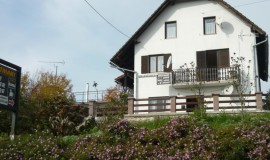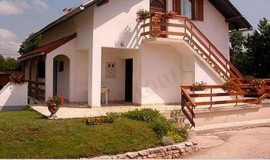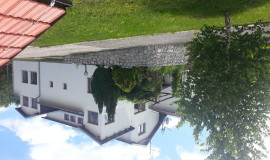
Gostinjska Kuca Aurora Plitvice lakes Croatia
Share This!

Join us on our most popular day trip. Discover why million people every year visit this pearl of world’s natural heritage that is on the UNESCO World Heritage List since 1979. Experience a unique blend of continental and maritime Croatia on sixteen remarkable cascade lakes. Timeless beauty of waterfalls thrills in every season in a different way. The perfect picture nature has been creating for several millenniums, leaving everyone breathless. Experience the birth of a vivid rainbow while getting refreshed with the scattered drops of 78 meters high waterfall. Find out why and how the Lakes change colors from emerald green to azure blue. Enjoy thousands of sparkling falls, clean pure air, the great Splasher, idyllical boat ride on Lake Kozjak, endemic flora and fauna and Lika’s food. Take a walk on one of 18 kilometres marked trails in unspoiled countryside or relax while driving on electric boat or small train. Only 2 hours from Zagreb, do not miss the opportunity for unique experience that attract visitors from all over the globe.
On the way to Plitvice we stop at small Millers village Rastoke usually called “Little Plitvice”. Rastoke is situated at the Slunjcica River estuary which over travertine barriers “dissolves” into the river Korana creating a series of small lakes and picturesque waterfalls. Experience this natural monument compared with famous Fontana di Trevi in 1860 by well known philologist and travel writer Adolf Veber Tkalcevic. Discover the rare symbiosis of fantastic natural creations and centuries old human technical achievements such as old mills from the 17th century. Enjoy the fresh caught trout, well known Lika lamb or veal, deer dishes and other specialties in restaurants smartly fitted in the nature. And if we get lucky – we meet the otters that build their homes in riverbanks burrows or under the rocky ledges of Rastoke.

Plitvice Lakes National Park, located in Croatia, in Dinaric Alps, was established in 1949. The natural wonder covers over 296.85 km2 of area. It is the most visited park in the region, attracting tourists from all around the world. The park is protected by UNESCO. The unique place is a result of karst hydrography. It is famous for the waterfalls, forest, lakes and diversity of animal species. The lakes float crystal water, that colors range from crystal clear to azure, to turquoise. The water color changes depending on the sunlight, minerals and organisms in the water.
Plitvice Lakes National Park, Croatia The tourists can choose from a wide range activities: from hiking and electric boat, to train ride, cycling, skiing and rowing. Many different species can be observed in the area, including brown bear, wolf, eagle, european pond turtle , lynx, wild cat, apercaillie can and many others. The brown bear sports on a Plitvice Lakes National Park logo. Plitvice Lakes National Park, Croatia The magnitude of the size, rarity and diversity of natural beauty, makes Plitvice Lakes National Park one of the places everyone should see at least once in their lifetime.

Archaeological research suggests that prehistoric settlements existed in the Park area, while ruins of a fortress of the Illyrian tribe Japodi have been found at the site known as “Gradina”. Here the Romans built watchtowers on the foundations of which a fortified monastery was later built. Its founders were most probably the Templars or the Paulines. Croats permanently settle here in the 7th Century. Turkish invaders are present in this area from 1528 to the beginning of the 18th century, when Austria established the Military Frontier, thus stopping the penetration of Turks into Europe. On the lakefronts, herders begin to settle erecting wooden huts in the forests and clearing the land to build settlements. From these shepherds huts developed the Lika log cabin with stone cellar, and steep roof covered with shingles or rye straw. On the large meadow of “Velika Poljana”, the Military Border Forest Administration, established in 1861, built the “Traveler’s Lodge”, dubbed by the people as the “Imperial Lodge” because it provided accommodation for imperial officers. In Labudovac, a trader from Senj called Devčić, built the first inn and sawmill, which was destroyed soon by fire. Zagreb resident, Janaček, renewed the inn and named it “Janaček’s Home in Labudovac”.
In 1896, the first hotel for 200 guests was built on “Velika Poljana”. This was a single-story building made of stone and wood in the style of the Military Border watchtowers. In 1920, the hotel was extended and modernized, but in 1939 was destroyed in a fire. Up to the 1960s, very popular residential, hotel and hospitality facilities had been built, which were designed by Croatian architects, such as Ostrogović, Haberle, Strižić, Horvat, Marohnić and I. Böhm, some of which were demolished, unfortunately, in the 1980’s as directed by the former administration. During the Homeland War, this whole area was occupied, the Croatian residents were banished and their houses destroyed and burnt down. Other buildings were damaged. Residential buildings in the settlements have been restored in the spirit of the architectural tradition and under terms of conservationists, while the public buildings are still under restoration. The especially valuable and most attractive buildings in the Park area are the traditionally crafted mills and sawmills driven by the power of water, which are gradually being restored and presented to visitors. In 2002, the mill in Korana village was restored, while the restoration of the “Špoljarić” sawmill is underway. According to international recommendations on the protection of cultural and natural heritage, which is based on the fact that natural and cultural heritage form a harmonious unity, it is necessary to protect the cultural heritage systematically in line with international conventions, and the high protection level of the Plitvice Lakes National Park commits us to do so.

There is no nightlife in Plitvice Lakes National Park, but the local hotels and restaurants often offer traditional live music performances Local services. There are three hotels in Plitvice Lakes and more accommodation possibilities can be found in the small nearby village of Korana. The reasonably priced restaurants in Plitvice Lakes serve mainly local specialties. There is no nightlife in Plitvice Lakes National Park, but the local hotels and restaurants often offer traditional live music performances.

Share This!

Kuća Obitelj Dukić nalazi se na mirnom i mirnom mjestu Ostarski stanovi, 12 km sjeverno od središnje turističke zone Nacionalni

Smještena u slikovitom parku Grabovac, Plitvička Vila nudi udoban smještaj i cijeli niz sadržaja, poput praonice rublja, terase i spremišta